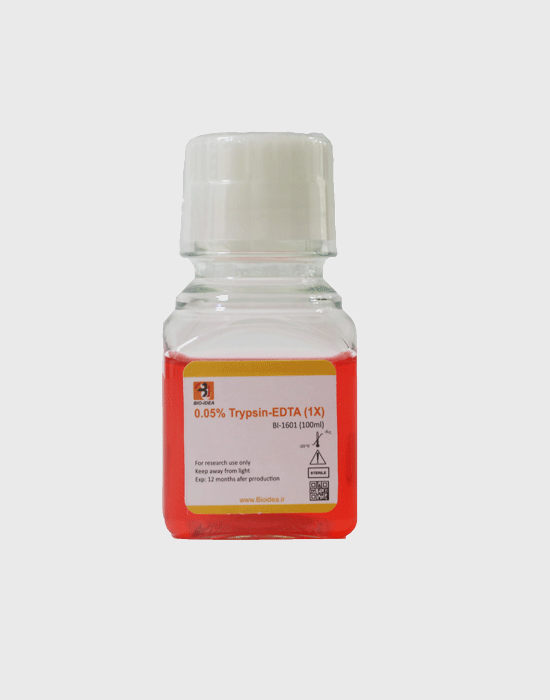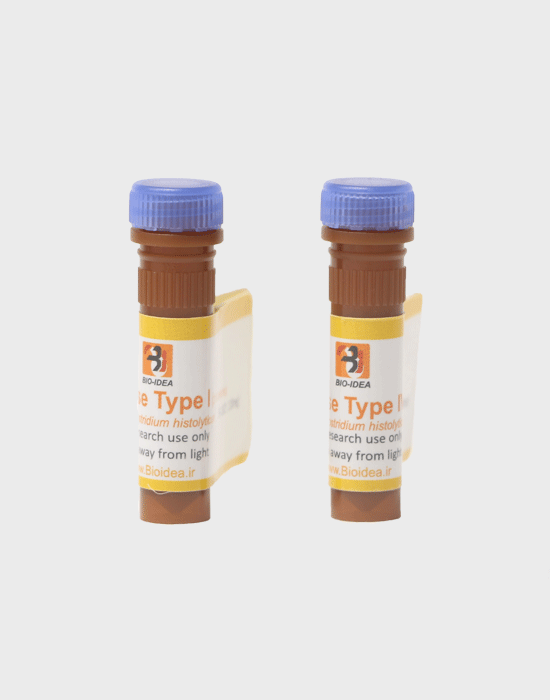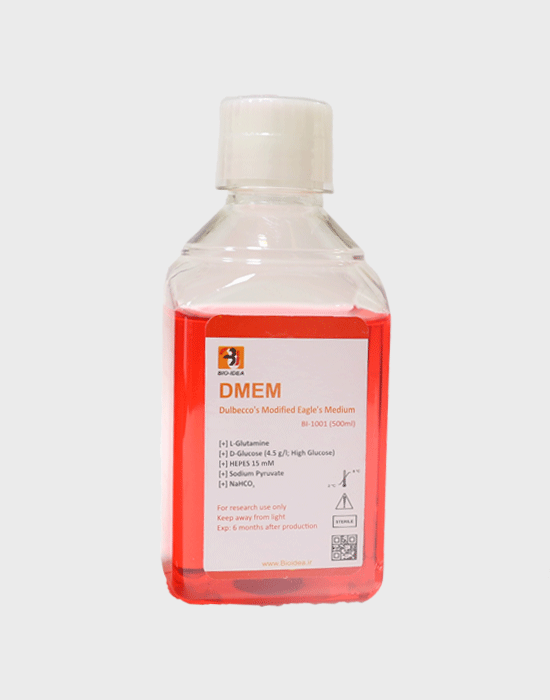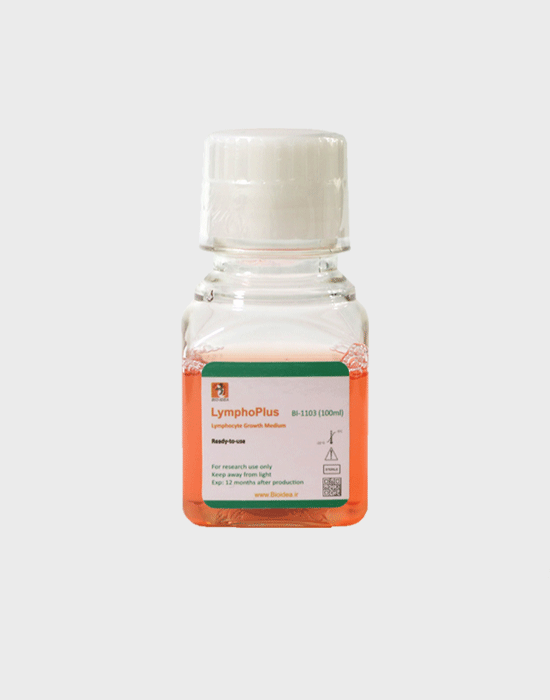Trypsin-EDTA(1X) 0.05%
Additional information
| Size | 100ml |
|---|---|
| Storage | -20 to -5 C |
| Shelf Life | 12 Month |
| Product Categories | Enzymes |
Additional information
| Size | 100ml |
|---|---|
| Storage | -20 to -5 C |
| Shelf Life | 12 Month |
| Product Categories | Enzymes |
Trypsin-EDTA(1X) 0.05%
معرفی محصول
Trypsin is a serine protease derived from porcine pancreas. It is a single chain polypeptide of 223 amino acid residue with substrate specificity based on positively charged Lysine and Arginine side chains. Trypsin predominantly cleaves peptide chains at the carboxyl sides of Lysine and Arginine, except when either is followed by Proline. It is most commonly used for dissociation and disaggregation of adherent cells.
$240
Description
Product Description
Trypsin is a serine protease derived from porcine pancreas. It is a single chain polypeptide of 223 amino acid residue with substrate specificity based on positively charged Lysine and Arginine side chains. Trypsin predominantly cleaves peptide chains at the carboxyl sides of Lysine and Arginine, except when either is followed by Proline. It is most commonly used for dissociation and disaggregation of adherent cells. Trypsin can also act to cleave ester and amide linkages of synthetic derivatives of amino acids. Also, ethylenediaminetetraacetic acid (EDTA), a chelating agent is often added to enhance enzymatic activity of trypsin solution. EDTA acts by neutralizing calcium and magne-sium ions that enhance cell to cell adhesion. The typical use for this product is in removing adherent cells from culture surfaces
Specification
This product is 0.05% Trypsin and EDTA in HBSS. Also, it contains sodium bicarbonate and phenol red in HBSS
Notes
Serine protease inhibitors, including DFP, TLCK, APMSF, AEBSEF, and aprotinin will inhibit Trypsin
The concentration of trypsin necessary to dislodge cells from their substrate is dependent primarily on the cell type, the age of the culture and confluency of cell cultures
This product is stored frozen between -10 and -40°C. Repeated cycles of freezing and thawing should be avoide
This product does contain phenol red. Due to shipment on dry ice, there could be significant carbon dioxide buildup in the package. This CO2 may enter the solution and lower the pH slightly, giving an orange rather than pinkish color. The orange solution will still be suitable for use, or the pH can be adjusted with sodium hydroxide
Incubating cells with too high a trypsin concentration for a long period can damage cell membranes and kill the cells
Solubilizing trypsin or diluting it from a concentrated solution should be done with a buffered salt solution containing no Ca2+ or Mg2+.
Trypsin solutions should be clear of particulates and flocculent material. Do not use if the solution is cloudy or contains a precipitate. Other evidence of deterioration may include degradation of physical or performance characteristics
How to Us
Before starting the implementation of any protocol, proper concentration of Trypsin-EDTA0.05% (BI-1601) solution and duration of incubation used for dissociation should be determined empirically for individual cell lines. Generally, Time required for dissociation of cells from a surface depends on cell type, cell density, the potency of trypsin, serum concentration in growth medium and time since the last subculture
Remove the spent medium from the culture vessel by aspiratio
Wash the monolayer by adding balanced salt solution without calcium and magnesium (PBS Minus: BI-1401) to the side of the flask opposite the cells
Rinse the cell sheet by moving the flask gently for 1 to 2 minutes and discard the wash solution
Add 0.05% Trypsin-EDTA (BI-1601) solution to the side of the flask opposite the cells. The volume should be sufficient enough to completely cover the monolayer of the cells
Move the flask gently to ensure that the dissociation solution covers the cell sheet
Incubate the flask at 37°C for 2 to 3 minutes. Monitor the process by observing the flask under an inverted microscope. When dissociation is complete, the cells will be in suspension and appear rounded. In addition to moving gently, flasks of cell lines that are characteristically difficult to remove from substratum may be tapped to expedite removae
Note: please note that the exact time needed to dissociate cells will vary according to the cell line. The dissociation pro cess should be monitored closely to avoid cell damage
Once the cell dissociation is complete add serum containing complete medium to the flask to inhibit the tryptic activity which may further damage the cells.
Disperse the cells into a single cell suspension by pipetting repeatedly
Count and subculture the cells
quality control
Appearance: red, clear solution
PH: 7.4 - 7.6
Sterility: Approved
Shelf life: 12 months
Storage
Upon receipt store the product at -20°C in a freezer that is self-defrosting. Once thawed, the product is stable for about 2 weeks at 2-8°C
Repeated freezing and thawing reduces enzymatic activity and should be avoided. Once thawed, the solution can be aliquoted in smaller volumes and frozen for future us
Additional information
| Size | 100ml |
|---|---|
| Storage | -20 to -5 C |
| Shelf Life | 12 Month |
| Product Categories | Enzymes |
ارجاعات
- Amini-Sarteshnizi, Nematallah, et al. “Anticancer activity of ethanolic extract of propolis on AGS cell line.”Journal of HerbMed Pharmacology 1 (2015).
- Hashemitabar, Mahmoud, et al. “Isolation and Characterization of Human Umbilical Cord Mesenchymal Stem Cells and Their Differentiation into Pdx-1+ Cells.”Journal of Biomedical Science and Engineering 11 (2015): 780.
- Amini-Sarteshnizi, Nematollah, et al. “Morphological changes of apoptosis and cytotoxic effects induced by Caffeic acid phenethyl ester in AGS human gastric cancer cell line.”Journal of HerbMed Pharmacology 2 (2014).
- Hadavi, M., et al. “Novel calcified gum Arabic porous nano-composite scaffold for bone tissue regeneration.” Biochemical and biophysical research communications 488.4 (2017): 671-678.
- Fayazi, Mehri, Mojdeh Salehnia, and Saeideh Ziaei. “Characteristics of human endometrial stem cells in tissue and isolated cultured cells: An Immunohistochemical Aspect.” Iranian biomedical journal 20.2 (2016): 109.
سوالات متداول
تريپسين
Be the first to review “Trypsin-EDTA(1X) 0.05%” Cancel reply
Related Products
مشتریان ما
ارائه محصولات باکیفیت به مشتریان، افتخار ماست







There are no reviews yet.